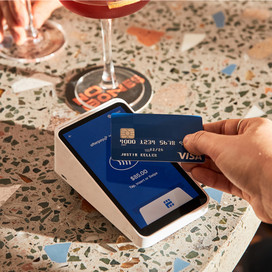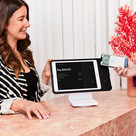In today’s digital world, if a customer doesn’t have a form of payment in hand, they can still make purchases. How? Making a purchase without being physically present is called a card-not-present (CNP) transaction.
What is a card-not-present transaction?
A card-not-present (CNP) transaction occurs when neither the cardholder nor the credit card is physically present at the time of the transaction. It’s most common for orders that happen remotely — over the phone, internet or mail.
A transaction is only considered to be “card present” if payment details are captured in person, at the time of the sale. This occurs when cards are physically tapped to a contactless reader or a PIN manually entered into a card reader by the customer.
Examples of card not present transactions
There are a number of CNP transactions that you probably come across everyday. They include:
- Online purchases, when a customer buys goods on the internet or through an e-commerce transaction.
- Phone orders, when a customer provides the credit card information over the phone to your business.
- Recurring payments that are set up to bill automatically.
- Invoices that are paid online.
How much does it cost to process credit cards remotely?
Just like processing credit cards in person, your business will have to pay to process CNP payments. As a refresher, the three main types of credit card processing fees that make up your rate are interchange fees, assessment fees (charged by card brands like Visa, Mastercard, eftpos, American Express and JCB) and your payment provider’s markup.
Generally, interchange fees are higher for CNP transactions because the chance of fraud and chargebacks is higher without the card present. These higher processing costs are then passed down to the merchant, which is why card-not-present transactions are usually more expensive than card-present transactions.
In the 2016-17 financial year, card fraud totalled $538.2 million in Australia, with CNP fraud accounting for 82 per cent of all fraud on Australian cards. Payments experts expect this number to gradually increase with the growth and adoption of e-commerce.
Understanding card-not-present fraud and how to prevent it
Card-not-present fraud is a type of credit card scam in which a defrauder uses someone else’s compromised card information to make a remote purchase. Because both the card and cardholder aren’t physically present (and fraudsters often steal complementary information like the CVV and billing address), it can be difficult for merchants to verify the purchaser’s identity.
As a business owners, there are several ways to protect against CNP fraud — you can read more about how Square implements these suggestions and works to keep businesses safe here. These security services add additional steps to customer’s shopping experience where the Card Verification Value (CVV) and billing address are cross checked before an order is finalised. If this information does not match the information provided by the customer, the order can be blocked.
An address verification system (AVS) is an effective way to verify the address of the person claiming to own the credit card. The system checks the billing address of the credit card provided by the customer with the address on file at the credit card company. This is why most payment processors, including Square, will ask you to verify your customer’s billing address before authorising a CNP charge.
Three easy ways to accept and process CNP cards with Square
With Square, there’s no need to sign up for a separate card-not-present merchant account to process online payments. Here are some of the affordable ways to process CNP transactions with Square.
- Utilise Invoices. Invoices are free to send — pay only 2.2% for each invoice paid. Invoices are a strong option for customers who don’t feel comfortable disclosing their payment details over the phone.
- Use Square Virtual Terminal (learn more below). This is ideal for orders taken remotely or over the phone.
- Implement Square’s e-commerce API. This allows you to process payments with Square on your own website.
Process a card-not-present transaction with Square Virtual Terminal
Square Virtual Terminal is a product offered by Square that lets you safely process credit cards over the phone. Simply open your Dashboard and turn any computer into a virtual POS system — no card reader or software needed — and for just 2.2% per keyed in payment .
Here are the steps to process a CNP transaction on Virtual Terminal:
- Sign up for your free Square account.
- On your Dashboard screen in the left side panel, click on Virtual Terminal.
- Click Take a Payment.
- Enter the credit card details for the transaction. You will need to enter the final order amount along with the customer’s credit card number, expiration date, CVV and billing postcode. The optional note field is great for leaving a personal thank you or to detail items.
- Click Charge.
![]()











